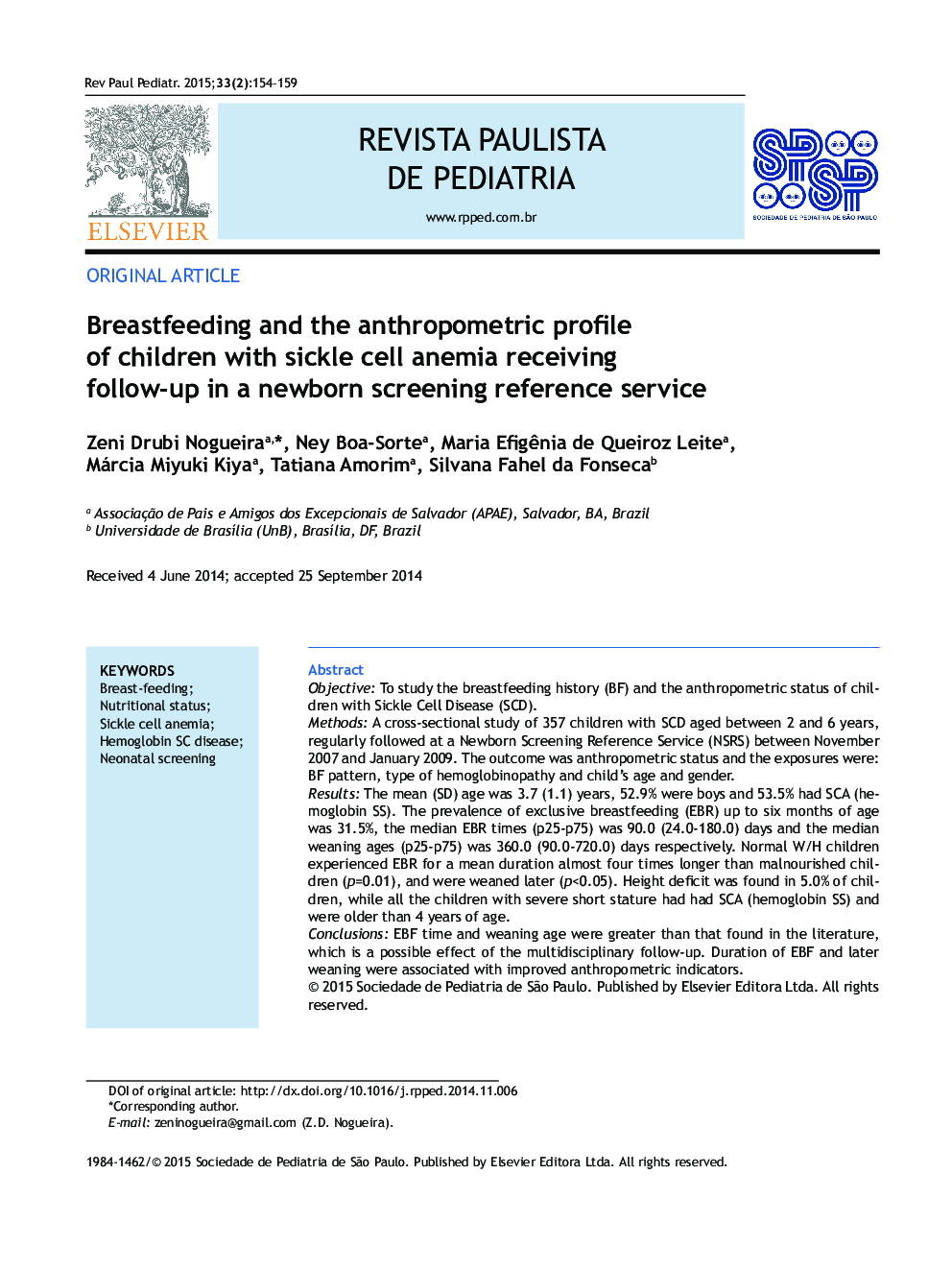| کد مقاله | کد نشریه | سال انتشار | مقاله انگلیسی | نسخه تمام متن |
|---|---|---|---|---|
| 4176257 | 1276241 | 2015 | 6 صفحه PDF | دانلود رایگان |
ObjectiveTo study the breastfeeding history (BF) and the anthropometric status of children with Sickle Cell Disease (SCD).MethodsA cross-sectional study of 357 children with SCD aged between 2 and 6 years, regularly followed at a Newborn Screening Reference Service (NSRS) between November 2007 and January 2009. The outcome was anthropometric status and the exposures were: BF pattern, type of hemoglobinopathy and child's age and gender.ResultsThe mean (SD) age was 3.7 (1.1) years, 52.9% were boys and 53.5% had SCA (hemoglobin SS). The prevalence of exclusive breastfeeding (EBR) up to six months of age was 31.5%, the median EBR times (p25-p75) was 90.0 (24.0-180.0) days and the median weaning ages (p25-p75) was 360.0 (90.0-720.0) days respectively. Normal W/H children experienced EBR for a mean duration almost four times longer than malnourished children (p=0.01), and were weaned later (p<0.05). Height deficit was found in 5.0% of children, while all the children with severe short stature had had SCA (hemoglobin SS) and were older than 4 years of age.ConclusionsEBF time and weaning age were greater than that found in the literature, which is a possible effect of the multidisciplinary follow-up. Duration of EBF and later weaning were associated with improved anthropometric indicators.
ResumoObjetivoDescrever a história de aleitamento materno (AM) e estado antropométrico de crianças com Doença Falciforme (DF).MétodosEstudo transversal com 357 crianças com hemoglobinopatias SS e SC de 2-6 anos de idade, acompanhadas regularmente num Serviço de Referência em Triagem Neonatal (SRTN) entre novembro de 2007 e janeiro de 2009. O desfecho correspondeu ao estado antropométrico e as exposições foram: padrão do AM, tipo de hemoglobinopatia, faixa etária e sexo da criança.ResultadosA média (DP) de idade observada foi de 3,7 (1,1) anos, sendo 52,9% meninos e 53,5% com hemoglobinopatia SS. A prevalência de aleitamento materno exclusivo (AME) até o 6º mês foi 31,5% a mediana (p25–p75) do tempo de AME foi de 90,0 (24,0-180,0) dias e a mediana (p25–p75) da idade de desmame foi de 360,0 (90,0-720,0) dias. Crianças eutróficas em relação ao P/A tiveram o tempo de AME, em média, quase quatro vezes maior que os desnutridos (p<0,01), bem como foram desmamadas mais tarde (p<0,05). O déficit de altura foi encontrado em 5,0% das crianças e todas as crianças com baixa estatura grave tinham hemoglobinopatia SS e mais de 4 anos de idade.ConclusõesO tempo de AME e a idade de desmame foram superiores aos encontrados na literatura, possível efeito do acompanhamento multidisciplinar. A duração do AME e a idade mais tardia de desmame foram associadas a melhores indicadores antropométricos.
Journal: Revista Paulista de Pediatria (English Edition) - Volume 33, Issue 2, June 2015, Pages 154–159
